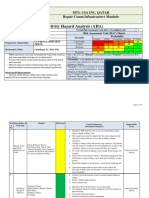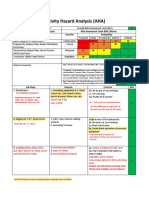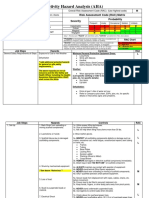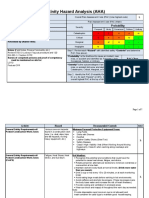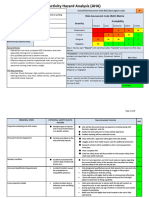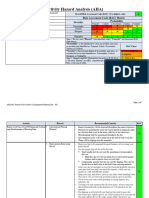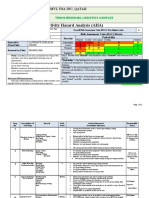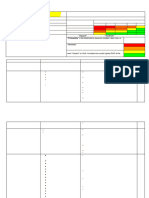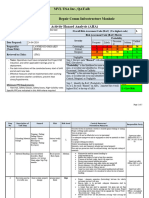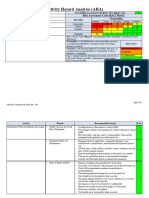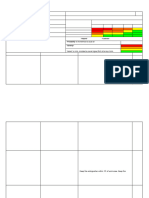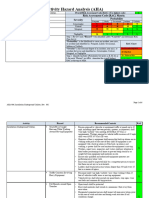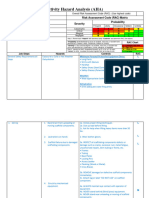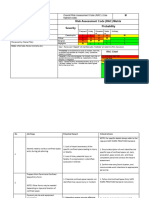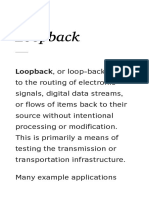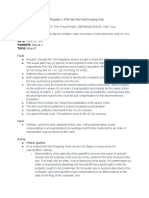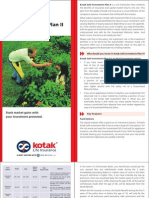AHA - Drywall
AHA - Drywall
Uploaded by
Jon CarloCopyright:
Available Formats
AHA - Drywall
AHA - Drywall
Uploaded by
Jon CarloCopyright
Available Formats
Share this document
Did you find this document useful?
Is this content inappropriate?
Copyright:
Available Formats
AHA - Drywall
AHA - Drywall
Uploaded by
Jon CarloCopyright:
Available Formats
Activity Hazard Analysis (AHA)
Activity/Work Task: Gypsum Board:
Finishing
Overall Risk Assessment Code (RAC) (Use highest code)
Project Location:
Risk Assessment Code (RAC) Matrix
Contract Number: Probability
Frequen
Date Prepared: Severity t Likely Occasional Seldom Unlikely
Prepared by (Name/Title): Catastrophic E E H H M
Critical E H H M L
Reviewed by (Name/Title): Marginal H M M L L
Negligible M L L L L
Notes: (Field Notes, Review Comments, etc.)
This activity hazard analysis (AHA) addresses Step 1: Review each “Hazard” with identified safety “Controls” and determine RAC (See above)
Gypsum Board Finishingat the CSI project site and is “Probability” is the likelihood to cause an incident, near miss, or
intended to be used with other project AHAs that accident and identified as: Frequent, Likely, Occasional, Seldom or RAC Chart
address task-specific hazards. Unlikely.
All personnel have pause/stop work for unsafe “Severity” is the outcome/degree if an incident, near miss, or E = Extremely High Risk
accident did occur and identified as: Catastrophic, Critical,
conditions. AHAs are subject to equirements of the
Marginal, or Negligible H = High Risk
APP/SSHP for revision approval/acceptance.
Step 2: Identify the RAC (Probability/Severity) as E, H, M, or L for M = Moderate Risk
each “Hazard” on AHA. Annotate the overall highest RAC at the
top of AHA. L = Low Risk
Job Steps Hazards Controls RAC
1. Material storage and handling Tripping, falling, inadequate passageway, fire in lumber storage Maintain safe storage areas with proper aisle clearance between
areas. rows of metal studs, drywall, and rough carpentry materials.
Keep materials covered and unexposed to weather. Use gloves
when handling stored items. Bend knees when carrying pails to L
decrease possiblity of back injury. Use equipment to move
materials safely. Fire extinguisher to be provided at intermediate
intervals.
2. Equipment / Tool Usage Cuts, eye injuries, contusions, excess noise from Chop saws All equipment to be safety checked prior to start up. Personal
and PAT’s, electrical shock. Ricochet from PAT’s. protective equipment to be worn as necessary for the work at
hand. Guards to be in place on all power tools and not removed
or rendered inoperable. Power cords to be in proper working
condition. Proper eye and ear protection will be used at all
times during usage. No smoking during activity. Only OSHA
approved gas containers to be used on the job and must be
L
stored a minimum of 10’ from equipment. Fire extinguishers to
be kept a minimum of 8’ from equipment.
3. Drywall Finishing Trips, falls, dust in eyes, cuts from razors. After walls have received drywall screwed to studs and track.
Precaution to be taken when opening pails of joint compound
and cutting of trim items. Proper work boots to be worn-no
tennis shoes or open toed shoes allowed. Hard hats and eye
protection to be worn at all times. Gloves to be worn as M
necessary. Work areas to be kept neat and clean. Scrap
materials to be disposed properly, daily. Use of dust masks is
mandatory when sanding.
4. Operation of Equipment Untrained operators, defective equipment, injured personnel Only qualified persons shall be assigned as operators.
slipping/falling off equipment, incipient fires. Equipment checklists shall be maintained and followed.
Equipment must be checked daily for safety compliance and
serviced on a regular basis. Operator shall never leave machine
or make repairs while it is still running or mobile. Climbing on
and off while equipment is running is prohibited. Seat belts shall M
be used at all times. Equipment to be kept free of mud, grease,
oil, etc. Only operator allowed on any part of the equipment.
Running boards and steps to be provided with non-slip surfaces.
No tools shall be left lying on any part of equipment. All
equipment to have at least one fire extinguisher rated 5BC.
5. Emergency Help Choking, minor injuries, first aid, etc. First aid facilities are located at the Jobsite Trailer and
Superintendent vehicles. At least one employee will be certified L
in CPR and First Aid. Report all accidents immediately.
6. Training Safety / Health / Accident Prevention Employees will review Safety Handbook. L
7. Hazard Communication Potential exposure to hazardous material. All shipments of products considered hazardous under HazCom
Standard must be properly labeled and accompanied by the appropriate
Material Safety Data Sheet (MSDS). All employees will be
L
trained in the “Right to Know” Standard, understand MSDS
forms and labeling, safety measures, and have access to all
MSDS’s.
8. Housekeeping Tripping, littering, pollution, rodents, insects, fire.
All debris to be put in dumpster on a continuous basis to avoid
debris blowing around project. Lunch/snack scraps shall be put L
in dumpster immediately after break.
Training Requirements/Competent or Qualified Personnel
Equipment to be Used Inspection Requirements
name(s)
Mixing Drill, Ladder, Mud Pan & Knife; Competent/Qualified Personnel: Inspect Guards and Cords Daily
OSHA Construction Safety & Health, First Aid, CPR, Power Inspect Scaffolding & Lifts Daily
Actuated Tools, Aerial Lifts, Scaffolding/Lift Inspection
Power Cords; Scissor Lifts
Inspect First Aid Kits Monthly
You might also like
- Concrete Works AHADocument9 pagesConcrete Works AHALawrence adeleke Omisakin100% (1)
- AHA Excavation and Backfill 030922-BDocument3 pagesAHA Excavation and Backfill 030922-BYug Dobariya75% (4)
- JHA - Ladders TemplateDocument3 pagesJHA - Ladders TemplateShannon Williams100% (2)
- AHA Temp Power - 03.03.2020 - RemarksDocument3 pagesAHA Temp Power - 03.03.2020 - RemarksJerry Word100% (1)
- Activity Hazard Analysis (AHA) : Risk Assessment Code (RAC) Matrix Severity ProbabilityDocument6 pagesActivity Hazard Analysis (AHA) : Risk Assessment Code (RAC) Matrix Severity ProbabilityAnthony Macatangay100% (1)
- AHA - Working On Slope RoofDocument2 pagesAHA - Working On Slope RoofTopsun Energy100% (3)
- Repair Concrete PDFDocument3 pagesRepair Concrete PDFJaycee Pagador100% (2)
- L Risk Assessment Code (RAC) MatrixDocument6 pagesL Risk Assessment Code (RAC) MatrixMario Marasigan50% (2)
- AHA Example For Scaffolding PDFDocument6 pagesAHA Example For Scaffolding PDFkaruna100% (1)
- Activity Hazard AnalysisDocument7 pagesActivity Hazard AnalysisAnthony MacatangayNo ratings yet
- AHA Conduit and Wiring Installation - TEMPLATEDocument7 pagesAHA Conduit and Wiring Installation - TEMPLATEKCV Coretech100% (1)
- Hall Effect Detailed Manual HolmarcDocument33 pagesHall Effect Detailed Manual HolmarcGreeshma100% (1)
- P-985-SH-AHA-003. AHA For Outage Lock Our Tag OutDocument3 pagesP-985-SH-AHA-003. AHA For Outage Lock Our Tag OutPatrick Bibila Ndansi100% (1)
- AhaDocument6 pagesAhaCarlits MacallaNo ratings yet
- Electrical Conduit InstallationDocument10 pagesElectrical Conduit InstallationYahya YusufzayNo ratings yet
- Magnetic SucceptibilityDocument5 pagesMagnetic SucceptibilityTarun BarthwalNo ratings yet
- AHA - Heavy Vehicle ParkingDocument16 pagesAHA - Heavy Vehicle Parkingvimal alaberahNo ratings yet
- AHA-005, Removal Asbestos Contaminated MaterialDocument7 pagesAHA-005, Removal Asbestos Contaminated MaterialBuddhikaNo ratings yet
- Column Casting AHADocument6 pagesColumn Casting AHALawrence OmisakinNo ratings yet
- AHA Ductbank InstallationDocument5 pagesAHA Ductbank InstallationYug DobariyaNo ratings yet
- Backfilling and Compaction MVLDocument3 pagesBackfilling and Compaction MVLLawrence adeleke OmisakinNo ratings yet
- Above Ground Chilled Water Pipe InsulationDocument3 pagesAbove Ground Chilled Water Pipe InsulationLawrence adeleke OmisakinNo ratings yet
- Mechanical Room Ductwork Demo Demo JHADocument9 pagesMechanical Room Ductwork Demo Demo JHAmanuelNo ratings yet
- AHA-003, ExcavationDocument5 pagesAHA-003, ExcavationBuddhika100% (2)
- Activity Hazard Analysis (AHA) : Risk Assessment Code (RAC) Matrix Severity ProbabilityDocument6 pagesActivity Hazard Analysis (AHA) : Risk Assessment Code (RAC) Matrix Severity ProbabilityAnthony MacatangayNo ratings yet
- AHA - Bucket Truck OperationDocument2 pagesAHA - Bucket Truck OperationJon CarloNo ratings yet
- Activity Hazard Analysis (AHA) : Risk Assessment Code (RAC) Matrix Severity ProbabilityDocument2 pagesActivity Hazard Analysis (AHA) : Risk Assessment Code (RAC) Matrix Severity ProbabilityYug DobariyaNo ratings yet
- MVL USA INC Site Telecomunication AHADocument7 pagesMVL USA INC Site Telecomunication AHALawrence adeleke OmisakinNo ratings yet
- 02 - B - AHA Framing and DrywallDocument4 pages02 - B - AHA Framing and Drywallmatthall55731No ratings yet
- Installation of PVC Conduit and AccessoriesDocument5 pagesInstallation of PVC Conduit and AccessoriesLawrence adeleke OmisakinNo ratings yet
- AHA - Erection of Purlins & Roof Liners in HangarDocument6 pagesAHA - Erection of Purlins & Roof Liners in HangarNAGARJUNANo ratings yet
- AHA-009, Construction & Removing FormsDocument4 pagesAHA-009, Construction & Removing FormsBuddhikaNo ratings yet
- AHA Flushing & Disinfection of Water SupplyDocument5 pagesAHA Flushing & Disinfection of Water SupplyLawrence adeleke OmisakinNo ratings yet
- Earth WorksDocument4 pagesEarth WorksLawrence adeleke OmisakinNo ratings yet
- AHA-002, Geotechnical WorkDocument5 pagesAHA-002, Geotechnical WorkBuddhikaNo ratings yet
- Waterline Tie-In With Existing Service AHADocument2 pagesWaterline Tie-In With Existing Service AHALawrence adeleke OmisakinNo ratings yet
- AHA For ExcavationDocument4 pagesAHA For ExcavationNAGARJUNANo ratings yet
- 02-Aha Pavement RemovalDocument5 pages02-Aha Pavement Removalpascua.jpmNo ratings yet
- KCF1-27 Activity Hazard METHOD STATEMENT FOR ABORTIVE WORK (DEMOLISHING)Document3 pagesKCF1-27 Activity Hazard METHOD STATEMENT FOR ABORTIVE WORK (DEMOLISHING)ansarabdul773No ratings yet
- P 985 SH AHA 003 AHA For Outage Lock Our Tag OutDocument3 pagesP 985 SH AHA 003 AHA For Outage Lock Our Tag Outm.alasemy2022No ratings yet
- X.9.1 Safety AHADocument5 pagesX.9.1 Safety AHABunyamin SelimogluNo ratings yet
- (En) Roof Repair Works 2019-03-14Document8 pages(En) Roof Repair Works 2019-03-14Anthony MacatangayNo ratings yet
- Demolisation AhaDocument3 pagesDemolisation AhaLawrence adeleke OmisakinNo ratings yet
- South Wall - Metal Panel Removal RWP JHADocument5 pagesSouth Wall - Metal Panel Removal RWP JHAmanuelNo ratings yet
- ADA Ramp Installation 061322-BDocument11 pagesADA Ramp Installation 061322-BYug Dobariya0% (1)
- BOSHDocument5 pagesBOSHJeffrey RegondolaNo ratings yet
- AHA WorksheetDocument6 pagesAHA WorksheetRev DezviNo ratings yet
- AHA-006, Installation Underground UtilitiesDocument6 pagesAHA-006, Installation Underground UtilitiesBuddhika100% (1)
- AHU Ductwork Demo Demo JHADocument11 pagesAHU Ductwork Demo Demo JHAmanuelNo ratings yet
- Activity Hazard Analysis - Scaffolding ErectionDocument6 pagesActivity Hazard Analysis - Scaffolding Erectionnoty boyNo ratings yet
- AHA-004, Earth Work Site PrepDocument6 pagesAHA-004, Earth Work Site PrepBuddhika100% (1)
- AHA - Scaffold Erecting and DismantlingDocument5 pagesAHA - Scaffold Erecting and Dismantlingmcowanwebowers.comNo ratings yet
- AHA - Confined Space EntryDocument10 pagesAHA - Confined Space EntryJon CarloNo ratings yet
- AHA - Lead and Asbestos WorkDocument3 pagesAHA - Lead and Asbestos Workdg6xkzxsc9100% (1)
- Interior Demo JHADocument12 pagesInterior Demo JHAmanuelNo ratings yet
- Electrical and Telecom WorksDocument7 pagesElectrical and Telecom WorksLawrence adeleke OmisakinNo ratings yet
- Activity Hazards Analysis (AHA) : Severity ProbabilityDocument8 pagesActivity Hazards Analysis (AHA) : Severity ProbabilitySAsaNo ratings yet
- AHA Fixed Scaffold OnlyDocument7 pagesAHA Fixed Scaffold OnlyJon CarloNo ratings yet
- AHA Example For ScaffoldingDocument7 pagesAHA Example For ScaffoldingVepxvia NadiradzeNo ratings yet
- Road Crushing Aha DuctDocument5 pagesRoad Crushing Aha DuctLawrence adeleke OmisakinNo ratings yet
- CH 07. Sales Responsibilities and PreparationDocument17 pagesCH 07. Sales Responsibilities and PreparationMohammad Zubair100% (1)
- Case Study PDFDocument7 pagesCase Study PDFSiddhantNo ratings yet
- LockingLadderPull 6-12 LoDocument8 pagesLockingLadderPull 6-12 LoAdriansyah Harry Adnan TanassalNo ratings yet
- Muthootfincorpltd 130220131348 Phpapp02Document123 pagesMuthootfincorpltd 130220131348 Phpapp02Abner Alexander Luiz100% (1)
- Professor Yashar Ganjali Department of Computer Science University of TorontoDocument56 pagesProfessor Yashar Ganjali Department of Computer Science University of TorontoDUDEKULA VIDYASAGARNo ratings yet
- SkySparc Appoints New CEO To Deliver Growth and Service ExcellenceDocument2 pagesSkySparc Appoints New CEO To Deliver Growth and Service ExcellencePR.comNo ratings yet
- Chapter 5 Data ProcessingDocument26 pagesChapter 5 Data ProcessingMelchor CarabayasNo ratings yet
- Full-Text STATCONDocument120 pagesFull-Text STATCONJIJAMNNo ratings yet
- Brainstorm Checklist 2018Document1 pageBrainstorm Checklist 2018vsrajeshvsNo ratings yet
- KSEEB Solutions For Class 7 Maths Chapter 1 Integers Ex 1.1 - KSEEB SolutionsDocument7 pagesKSEEB Solutions For Class 7 Maths Chapter 1 Integers Ex 1.1 - KSEEB Solutionsprashant.acharyahnrNo ratings yet
- Loopback: Loopback, or Loop-Back, RefersDocument20 pagesLoopback: Loopback, or Loop-Back, RefersOnyekachi JackNo ratings yet
- JonckheereDocument8 pagesJonckheerePhilippine Bus Enthusiasts SocietyNo ratings yet
- Plumlee & Yohn - 2010 - An Analysis of The Underlying Causes of Attributed To RestatementsDocument25 pagesPlumlee & Yohn - 2010 - An Analysis of The Underlying Causes of Attributed To Restatementsall_xthegreatNo ratings yet
- Páginas Desde0460 - w17 - QP - 12Document9 pagesPáginas Desde0460 - w17 - QP - 12Ruth.go06 from CHI StudentNo ratings yet
- LIKUJYHTGRFDocument4 pagesLIKUJYHTGRFYash BhatnagarNo ratings yet
- Stata Working With Ado FilesDocument4 pagesStata Working With Ado Fileschala24No ratings yet
- Cyber Laws Sybcom DDocument11 pagesCyber Laws Sybcom DVettayan VelNo ratings yet
- 1 CASE STUDY Performance Management New Directions in Appraisal and EvaluationDocument7 pages1 CASE STUDY Performance Management New Directions in Appraisal and EvaluationAnju Dwivedi ShuklaNo ratings yet
- Reviewer Notes Consti 1Document4 pagesReviewer Notes Consti 1NefreterieGelitoAngNo ratings yet
- Weekly Spending: Date In/Out Amount $ + / - + / - + / - + / - $ $ CategoryDocument8 pagesWeekly Spending: Date In/Out Amount $ + / - + / - + / - + / - $ $ CategoryRasmus PieplowNo ratings yet
- Sra Notice 1Document3 pagesSra Notice 1Ghanshyam mishra100% (1)
- Fluid Mechanics 230: Dr. Law Ming ChiatDocument28 pagesFluid Mechanics 230: Dr. Law Ming ChiatJack JongNo ratings yet
- Class D 2093Document34 pagesClass D 2093Đoàn Minh CươngNo ratings yet
- Chemcrete Profile 18072022Document25 pagesChemcrete Profile 18072022muhammad naumanNo ratings yet
- 588 RP V Phill-Vill Housing and DevelopmentDocument2 pages588 RP V Phill-Vill Housing and DevelopmentKrisha Marie CarlosNo ratings yet
- Saas Overview (Software As A Service) : GartnerDocument15 pagesSaas Overview (Software As A Service) : GartnerTarun SinghNo ratings yet
- The Role of Social Worker-Post Disaster SituationDocument4 pagesThe Role of Social Worker-Post Disaster SituationDenver John Tacderas SolivenNo ratings yet
- Intergas Brochure - NewDocument6 pagesIntergas Brochure - NewDan RobinsonNo ratings yet
- Embankment PDFDocument5 pagesEmbankment PDFTin Win HtutNo ratings yet
- Kotak Safe Investment Plan2Document4 pagesKotak Safe Investment Plan2Drashti Investments100% (2)
